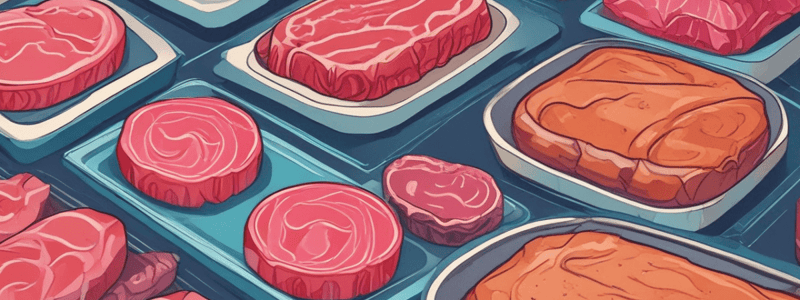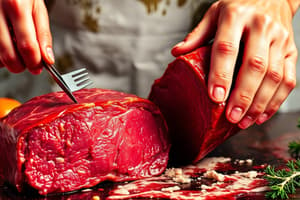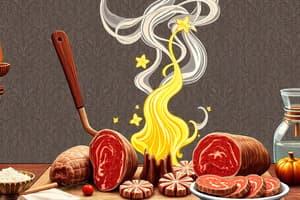Podcast
Questions and Answers
Moist-heat cooking methods are ideal for short, rapid cooking procedures.
Moist-heat cooking methods are ideal for short, rapid cooking procedures.
False (B)
Which cut of meat is ideal for roasting?
Which cut of meat is ideal for roasting?
- Rib or loin cuts
- Chuck or shoulder
- Leg or round (correct)
- Shanks, breast, brisket, or flank
Why are shanks ideal for braising and boiling?
Why are shanks ideal for braising and boiling?
Because their high collagen content is transformed into gelatin, which adds body to braising liquids and improves meat eating quality.
The most sensitive cuts of meat are always utilised for ________.
The most sensitive cuts of meat are always utilised for ________.
Match the following cuts of meat with their ideal cooking methods:
Match the following cuts of meat with their ideal cooking methods:
Pork and mutton are typically served medium rare.
Pork and mutton are typically served medium rare.
What is the reason why shoulder roasts are not the most appealing?
What is the reason why shoulder roasts are not the most appealing?
What can be derived from any primal cut?
What can be derived from any primal cut?
Why are meats with high fat content, such as buff, lamb, or mutton, typically cooked without the addition of fat?
Why are meats with high fat content, such as buff, lamb, or mutton, typically cooked without the addition of fat?
Searing a steak at high heat actually seals the pores to keep juices in.
Searing a steak at high heat actually seals the pores to keep juices in.
What is the purpose of barding and larding when cooking lean meats?
What is the purpose of barding and larding when cooking lean meats?
Meats with low-fat content are frequently cooked with extra ______________ to prevent dryness.
Meats with low-fat content are frequently cooked with extra ______________ to prevent dryness.
Match the following cooking methods with their effects on meat:
Match the following cooking methods with their effects on meat:
What is another objective of cooking, besides developing tenderness?
What is another objective of cooking, besides developing tenderness?
Ground meat and cubed steaks can be cooked using only moist heat.
Ground meat and cubed steaks can be cooked using only moist heat.
What is the result of preliminary browning of a roast over high heat?
What is the result of preliminary browning of a roast over high heat?
What is the primary reason for proper meat storage?
What is the primary reason for proper meat storage?
Fresh meats should be wrapped tightly to prevent drying.
Fresh meats should be wrapped tightly to prevent drying.
What is the ideal temperature range for storing fresh meats?
What is the ideal temperature range for storing fresh meats?
Meat should be stored loosely organised on pans or racks to enable _______________________ between portions.
Meat should be stored loosely organised on pans or racks to enable _______________________ between portions.
Which of the following cuts of meat is known for its tenderness?
Which of the following cuts of meat is known for its tenderness?
Vacuum-packed meats should be opened immediately upon arrival.
Vacuum-packed meats should be opened immediately upon arrival.
Match the following cuts of meat with their characteristics:
Match the following cuts of meat with their characteristics:
Flashcards are hidden until you start studying
Study Notes
Storage of Meats
- Proper storage is critical to avoid spoilage and maintain quality of meat products.
- Fresh meat spoils quickly, so it's essential to inspect purchases, store loosely, and cover sliced surfaces.
- Store at 32°--36°F (0°--2°C) to slow down bacterial and mold growth.
Fresh Meats
- Inspect purchases to ensure high quality.
- Avoid tight wrapping to prevent bacterial and mold growth.
- Store loosely on pans or racks to enable air circulation.
- Cover sliced surfaces to prevent excessive drying.
Cooking Characteristics of Different Cuts
Rib and Loin Cuts
- Most tender cuts, ideal for roasts, steaks, and chops.
- Frequently used for roasting, broiling, and grilling.
- Can be served medium rare, medium well, or well done.
Leg or Round
- Tender enough to roast due to broad muscles and uniform grain.
- Ideal for roasting, easy to slice, and appealing pieces.
Chuck or Shoulder
- Typically braised, but can be roasted or chopped into chops for broiling.
- Not ideal for roasting due to multiple small muscles and varying directions.
Shanks, Breast, Brisket, and Flank
- Least tender cuts, typically cooked with wet heat.
- Ideal for braising and boiling due to high collagen content.
Ground Meat, Cubed Steaks, and Stew Meat
- Can be derived from any primal cut.
- Mechanically tenderized, can be cooked using dry or moist heat.
Other Factors Influencing Choice of Cooking Methods
Fat Content
- Meats with high fat content (e.g., buff, lamb, or mutton) are cooked without added fat.
- Meats with low fat content are cooked with extra fat to prevent dryness.
- Barding and larding are techniques to add fat to lean meats.
Developing Tenderness Is Not the Only Goal Of Cooking
- Other objectives include developing flavor, preventing excessive shrinkage and nutrient loss, and changing appearance.
- Compromises may be necessary to achieve a balanced output.
Searing and "Sealing"
Searing
- Browning surfaces at high heat imparts desirable flavor and color.
- Does not "seal the pores" as meat does not have pores, but rather a network of open fibers.
- Preliminary browning can increase shrinkage, but may be beneficial for flavor and appearance.
Studying That Suits You
Use AI to generate personalized quizzes and flashcards to suit your learning preferences.




